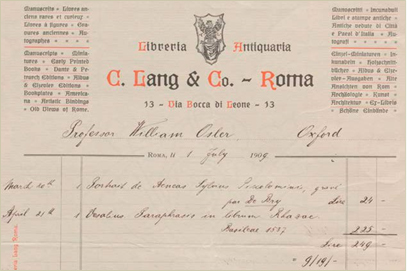
Among the most important archival material connected with McGill’ Osler Library is that of the library’s founder, Sir William Osler (1849–1919). A major figure in modern medical history, Osler is well known as a scientific researcher, a great medical pedagogue, a humanist, and an advocate for a patient-centered approach to medicine.
Born in Ontario and educated at McGill University, he taught at McGill’s Faculty of Medicine from 1874 until 1884 before leaving to join the faculty at the University of Pennsylvania in Philadelphia, and then to become one of the “Big Four” founders of Johns Hopkins Hospital and medical school in Baltimore, the first to train medical students in a modern residency program.
He finished his career as Regius Professor of Medicine at Oxford University, where he was also able to devote time to his passion for book collecting. His library of nearly eight thousand rare and historic works of the history of medicine and science is known as the Bibliotheca Osleriana, documented by a published catalogue of the same title.
The Sir William Osler Collection, distinct from the Bibliotheca, is an extensive archival holding of Osler’s correspondence (including eighteen hundred original letters), daybooks, notebooks, lectures, and book invoices, as well as photographs. The collection also contains various family papers, including the correspondence of Lady Grace Revere Osler.
Shown above is a 1909 invoice for the 1537 Paraphrasis in nonum librum Rhazae by Andreas Vesalius (1514–1564), which became part of the Bibliotheca Osleriana, B.O. 580. Osler considered Vesalius one of the greatest anatomists in medical history and collected his works extensively. This book was Vesalius’s bachelor of medicine thesis from the University of Leuven. Invoices such as this one make it possible to understand Osler as a collector and reader, showing the range of booksellers that he was in contact with internationally, the prices that he paid for various titles, and also when he acquired them. This kind of evidence is equally valuable for historians of the book trade more generally.
Archival traces of Osler are held in other McGill collections as well. Nearly forty-five hundred additional letters to or from William Osler are found, for example, in the Harvey Cushing Fonds. Cushing (1869–1939) was a pioneering neurosurgeon and close friend of Osler, and after Osler’s death Cushing undertook to write his biography, collecting and copying letters from Osler’s numerous friends and correspondents. Another important trace of Osler’s work is his interleaved copy of the first edition of the famous medical textbook The Principles and Practice of Medicine, replete with his handwritten additions and emendations for the second edition. This volume, a mixture of manuscript and print, is part of the Bibliotheca Osleriana, along with several unpublished manuscripts and notebooks.
